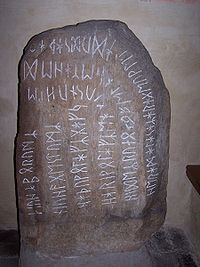Rundata ID DR 357 City/Village Stentoften Runemaster Unknown | Produced 500-700AD | |
 | ||
The Stentoften Runestone, listed in the Rundata catalog as DR 357, is a runestone which contains a curse in Proto-Norse that was discovered in Stentoften, Blekinge, Sweden.
Contents
Transliteration
AP niuhAborumz ¶ niuhagestumz ¶ hAþuwolAfz gAf j ¶ hAriwolAfz (m)A--u snuh-e ¶ hidez runono fe(l)(A)h ekA hed¶erAAQ niu hAborumz ¶ niu hagestumz ¶ hAþuwolAfz gAf j ¶ hAriwolAfz (m)A--u snuh-e ¶ hidez runono fe(l)(A)h ekA hed¶erAB ginoronozC herAmAlAsAz ¶ ArAgeu we(l)Aduds| |sA þAtD bAriutiþTranscription
AP <niuha>borumz <niuha>gestumz Haþuwulfz gaf j[ar], Hariwulfz ... ... haidiz runono, felh eka hedraAQ niu habrumz, niu hangistumz Haþuwulfz gaf j[ar], Hariwulfz ... ... haidiz runono, felh eka hedraB ginnurunoz.C Hermalausaz argiu, Weladauþs, sa þatD briutiþ.Translation
This is the English translation provided by Rundata:
AP(To the) <niuha>dwellers (and) <niuha>guests Haþuwulfar gave ful year, Hariwulfar ... ... I, master of the runes(?) conceal hereAQ nine bucks, nine stallions, Haþuwulfar gave fruitful year, Hariwulfar ... ... I, master of the runes(?) conceal hereB runes of power.C Incessantly (plagued by) maleficence, (doomed to) insidious death (is) he who thisD breaks.Interpretation
In lines AP and AQ, in the phrase "gaf j" ("gave j"), the j-rune is an ideogram which stands for its rune name jara, meaning "harvest" or "bountiful or fruitful year." One author suggests that line AQ is describing an animal sacrifice in return for a good harvest as part of a fertility ritual.
History
The Stentoften runestone was discovered in 1823 by the dean O. Hammer. It was lying down with the inscription facing downwards, surrounded by five sharp larger stones forming a pentagon or a pentagram. Consequently, the stone has been part of a larger monument like the Björketorp Runestone further east. In 1864, the runestone was moved into the church of Sölvesborg.
Most scholars date the inscription to the 7th century and it is carved with a type of runes that form an intermediate version between the Elder Futhark and the Younger Futhark. A characteristic example of this is the a-rune which has the same form as the h-rune of the younger futhark. This is the rune that is transliterated with A. The k-rune, which looks like a Y is a transition form between and in the two futharks. There are quite few intermediary inscriptions like this one. Three more are known from Blekinge, i.e. the Björketorp Runestone, the Istaby Runestone and the Gummarp Runestone, which were moved to Copenhagen and lost in the Copenhagen Fire of 1728.
The Stentoften, Istaby Runestone and Gummarp Runestone inscriptions can be identified with the same clan through the names that are mentioned on them, and the names are typical for chieftains. The Björketorp Runestone lacks names and is raised some tens of kilometers from the others. However, it is beyond doubt that the Björketorp runestone is connected to them, because in addition to the special runic forms, the same message is given on the Stentoften Runestone. It is obvious that these runestones are not carved by the same man, and so it appears that the runestones reflects a specific runic tradition in the Blekinge area during the 7th century. Runologist Michael Schulte suggests that the archaic text of the Stentoften stone is more effective from a dramatic perspective than the younger and more explicit version on the Björketorp stone.
The name Hariwulfa is a combination of hari meaning "warrior" and wulafa "wolf," while the haþu of Haþuwulfz means "battle." It has been suggested that the assignment of such lycophoric names may have been related to ritualistic practices and religious wolf-symbolism used in the initiation of young warriors. A shortened form of the name Hariwulfa survived into the Viking Age and is attested in the inscription on the Hærulf Runestone.
